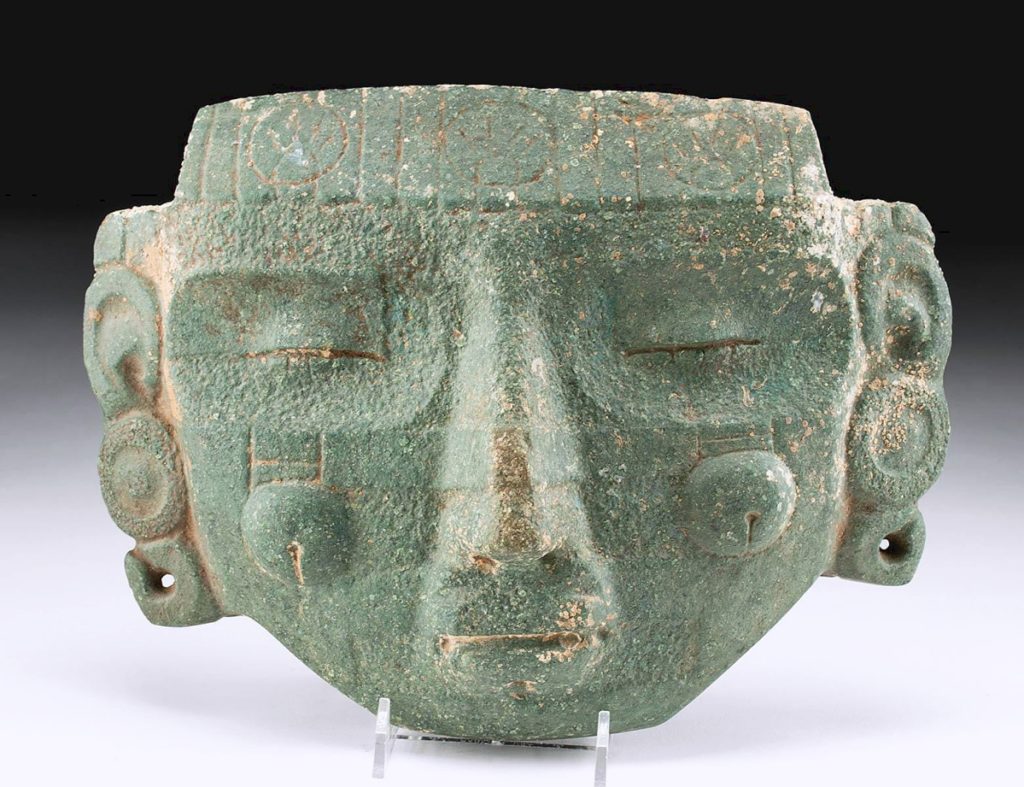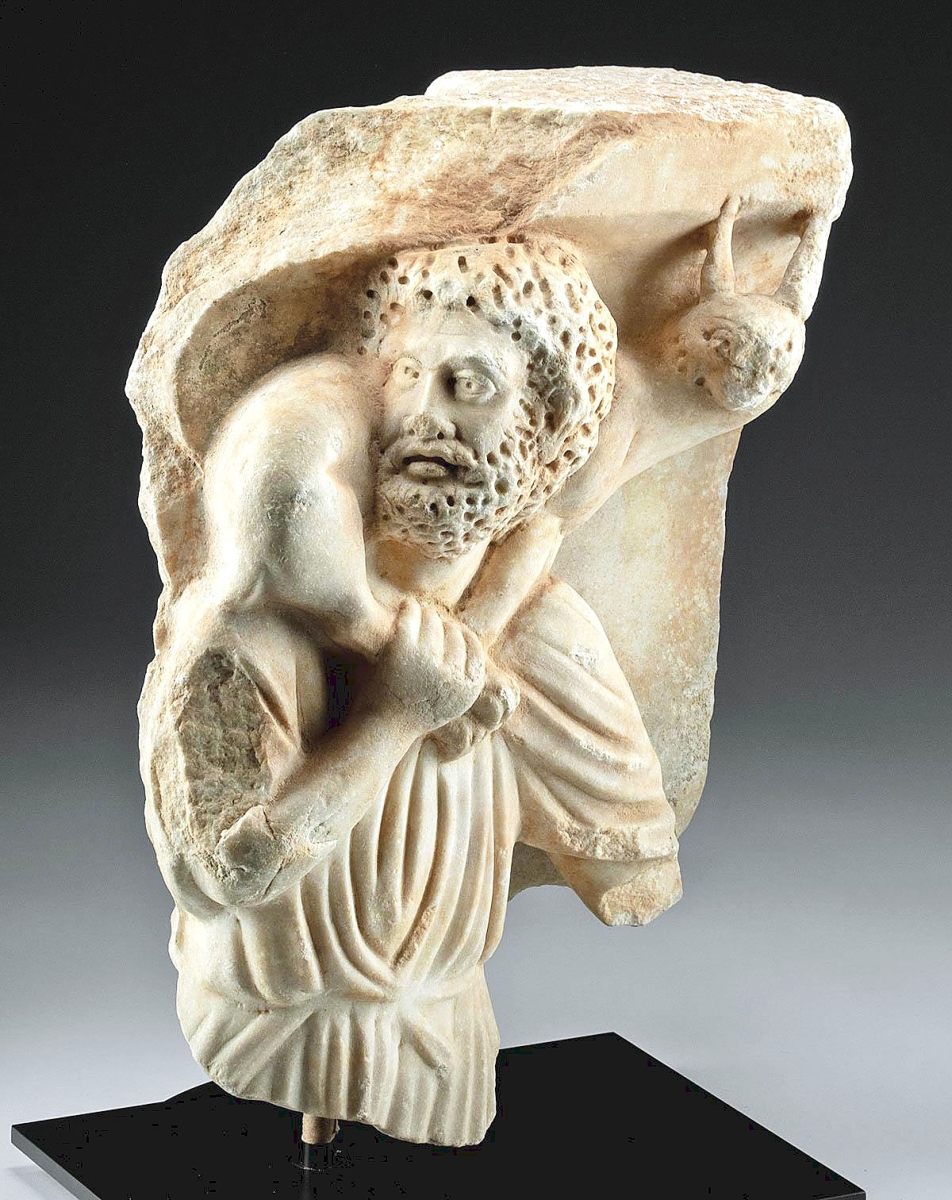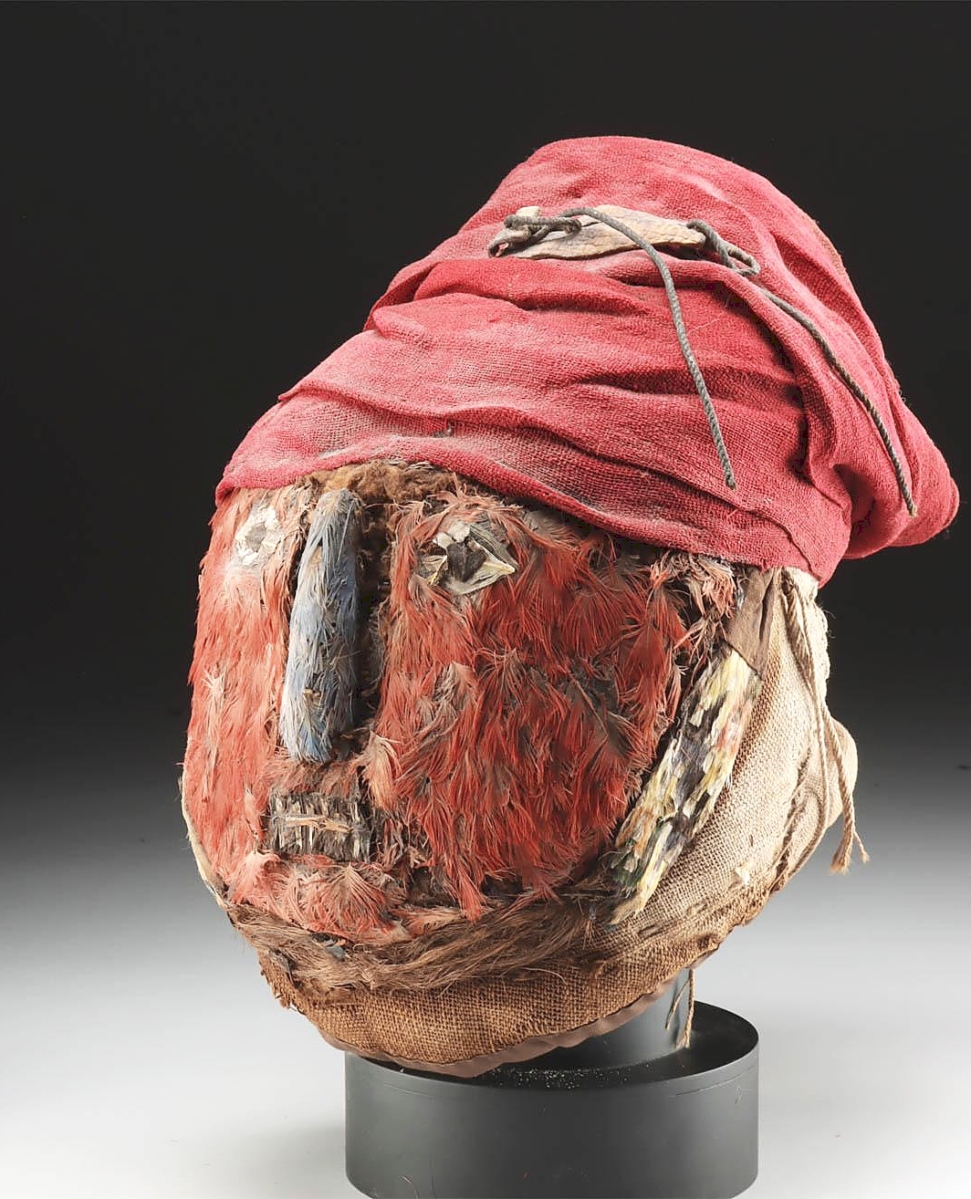
Greenstone mask of the slain Aztec moon goddess carved during the reign of Moctezuma II that sold at the top of the auction for $36,053.
Review by Z.G. Burnett, Photos Courtesy of Artemis Gallery
LOUISVILLE, COLO. – Artemis Gallery conducted the Exceptional Antiquities, Ethnographica & Fine Art auction on November 10, offering 385 lots. These included examples from classical antiquity (Greek, Roman and Near Eastern), Asia, Oceania, the Americas, Africa and the Viking and early Christian era, as well as fine art and wonders of the natural world.
Many of the top lots were pre-Columbian, including the highest priced object of the sale, an “extraordinarily rare” Aztec greenstone mask of the moon goddess Coyolxauhqui from the Sixteenth Century that bid to $36,053. The goddess’ name translates to “painted with bells,” and she is traditionally depicted with her eyes closed, bedecked with a feather headdress and bells. Coyolxauhqui revolted against her mother, the earth goddess Coatlicue, and was beheaded by her brother, the sun god and patron deity of the Mexica, Huitzilopochtli. On the verso is a glyph of Moctezuma II (circa 1466-1520) wearing royal ornaments, its image perhaps warning against betrayal of this powerful ruler.
An unusual sculptural object that achieved a top price in this category was earlier and from farther south in the Americas, a false Huari (Wari) or Tiwanaku (Tiahuanaco) mummy mask from coastal Peru, made circa 600 to 1000 CE. Once used as a head covering for an elite member of society, probably male, the head is made with either llama or alpaca wool and cotton fabric, a wooden nose, and decorated with the feathers of jungle birds, which were a precious commodity. These masks were made to give a face to the deceased and was remarkably preserved due to the dry Andean climate. This example achieved $13,599.
Two more pre-Columbian sculptures carved from stone were prominent in the sale: an Aztec rattlesnake curled into a ball and ready to strike, and a Maya carving of Tlaloc or Chaac, the god of rain. The serpent dated from 1325 to 1475 CE and came from central Mexico and was associated with Quetzacoatl, a mythical feathered snake, represented power, rebirth, transition and renewal due to the annual shedding of their skin. The serpent sold for $9,488.

This marble relief from the Third to Fourth Century CE could be Hermes Kriophoros, the Good Shepherd, or an example of early (and illegal) Christian art. While the ram over Hermes’ shoulders was originally meant to be sacrificial, it was later an attribute of the “shepherd watching over his flock.” Bidding carried the ambiguous image to $12,018.
Just as fierce, or even more so, was Tlaloc, from the Cotzumalguapa region (southern Mexico to Guatamala) and dated 650 to 900 CE. Standing 20 inches high, the basalt figure stands on a base that suggests it was once an architectural pediment. The “S” on his hand is part of the glyph for “clouds” and the forked tongue of his fearsome visage symbolizes verdant greenery. The deity bid to $8,972.
The only work of Asian art in the sale was a phyllite stone relief panel of Green Tara or Shyamatara, a protective mother and savior goddess that claimed second place in the top lots for $28,463. Made in the Bihar region of India during the Pala Empire (circa Tenth to Twelfth Century CE), the sculpture is a devotional object that would have been featured in the niche of a temple or shrine. Tara is the goddess of supreme compassion and the most important deity in Tibet, where she’s called Sgrol-ma or Shyamatara.
Third in the sale was an Imperial Roman (circa First to Fourth Century CE) marble portrait of a bearded, balding man, realistically portrayed to convey the years he devoted to the Empire, which sold for $20,096. It was common in very early Rome for men to let their beards grow until, according to Pliny (circa 23-79), a Sicilian barber set the trend for regular shaving. Only lower-class men or men in mourning would let their beards grow, and a young boy’s first shave was a milestone in manhood, a tradition that continues today. Emperor Hadrian (reigned 117-138 CE) brought beards back into fashion, and it became customary for emperors to wear them until Constantine the Great (reigned 306-337 CE). Another later Imperial limestone portrait of a young Palmyrene woman sold for $11,298, showing the more idealized features and sharper lines of the regional style.

Huari (Wari) or Tiwanaku (Tiahuanaco) ceremonial mask or false mummy head, put $13,599 to rest.
Taino ritual art and objects were popular among bidders, especially “zemis,” which are deities, ancestors or earth spirits. Zemi figures are believed to house these powerful spirits and would be honored with offerings by those who housed them. Chief among these was a guayacan wood zemi figure that symbolized hallucinogenic transformation and served up the means; the figure holds a platter that contained traces of cohoba, a vegetal entheogen that was inhaled during rituals, and sold for $12,650. Another unique zemi face carved from a single piece of brain coral from the Caribbean ranked among the top lots, showing the skeletal features of a face with mouth agape. The striking carving was also an example of the Taino peoples’ dependence on and reverence for the ocean as a source of food, as well as a mysterious realm of spirits. The zemi went to a new home for $8,539.
Each of the sale’s top Egyptian artifacts were funerary objects, but only one included actual remains. An incredibly well-preserved mummy of an ibis and an accompanying, framed x-ray of the bundle continued its long afterlife for $7,837. From the Late Dynastic to Roman period (circa 400 to 200 CE), the ibis was found at Abydos by the Egyptian Exploration Society around 1910 and later given to MacMurray College by Dr Wallace N. Stearns.
The expert linen wrapping shows the meticulous care with which these birds were treated as offerings to Thoth, the ibis-headed god of wisdom often shown as a scribe. According to the object description, “millions” of these have been found at Saqqara and Abydos, where many pharaohs were entombed. The mummy may have once had a bronze ibis’s head attached, now lost.
Prices quoted include buyer’s premium as reported by the auction house. For information, 720-890-7700.




















